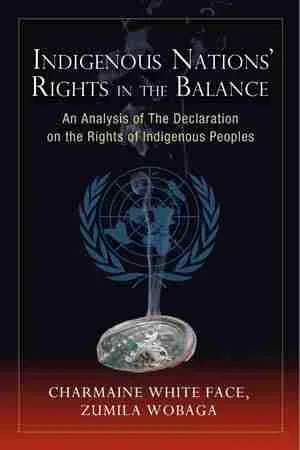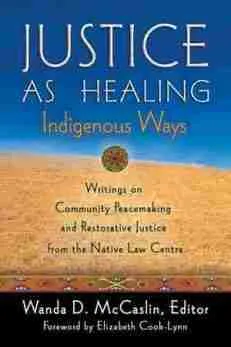Description
Comparing three different versions of the UN Declaration on the Rights of Indigenous Peoples (DRIP), Indigenous Nations’ Rights in the Balance analyses the implications of the changes made to DRIP for Indigenous Peoples and Nations.
This is a foundational text for Indigenous law and rights and the global struggle of Indigenous Peoples in the face of modern states.
Between 1994 and 2007, three different versions of the Declaration on the Rights of Indigenous Peoples were passed by various bodies of the United Nations, culminating in the final version passed by the UN General Assembly. Significant differences exist between these versions—differences that deeply affect the position of all Indigenous Peoples in the world community.
In Indigenous Nations’ Rights in the Balance, Charmaine White Face gives her well-researched comparative analysis of these versions. She puts side-by-side, for our consideration, passages that change the intent of the Declaration by privileging the power and jurisdiction of nation states over the rights of Indigenous Peoples. As Spokesperson representing the Sioux Nation Treaty Council in UN proceedings, she also gives her insights about each set of changes and their ultimate effect.
Reviews and Comments
Charmaine White Face, a Lakota Wiyan from Pine Ridge, S.D., who is devoted to the political rights of indigenous peoples, gives us here a lucid and implacable analysis of the crucial relationship between Indians and their colonizers. Her work in Geneva, Switzerland, as well as her defense of the Black Hills of the North Plains region, challenges the United Nations Human Rights declaration of 2007 as deeply flawed. In examining the role of the UN, she charges that it has again through its recent declarations provided legitimacy and prestige not only to historical eighteenth-century genocide, but to the continuing plunder of rights and resources of native peoples. Her profoundly disturbing message forces us to ask the question: what happens when international law says powerful nations can use the idea of law as a weapon to gain consensus for theft? The so-called rule of law, as “discoverers” have shown us from the beginning, entrenches legal doctrines that justify genocide. The UN complicity, White Face tells us, has enormous consequences. No readers of this little text can dismiss the logic of her analysis if we are to learn the lessons of history.
Charmaine White Face is the Rachael Maddow of the Lakota political world concerning environmental and civil rights…. Her research is flawless. Her opinions are provocative and courageous and path breaking…. This is a good read.
—Elizabeth Cook-Lynn, Hunkpati Dakota
Author of A Separate Country: Postcoloniality and American Indian Nations
Charmaine White Face’s mesmeric account of the Declaration painstakingly reveals the enormous difficulties that Native nations face in their quest to have their rights and resources respected by their host states and by the international community at large. The tortured process she described reveals that states interpret the phrase “rule of law” to mean “their rules and their laws,” leaving indigenous peoples even now at the mercy of states and state-dominated institutions, like the U.N.
—David E. Wilkins, Lumbee
Co-author of Uneven Ground: American Indian Sovereignty and Federal Law
Does the UN Declaration on the Rights of Indigenous Peoples actually protect indigenous rights? Charmaine White Face provides a series of powerful arguments and direct documentation that indigenous rights were passed over in favor of nation-state powers and jurisdiction over indigenous nations within nation states. Many indigenous organizations that participated in the long negotiations of the Declaration did not give their consent to the final UN versions of the Declaration. The final form of the declaration ignored indigenous self-government, rights to territory, plural citizenship, rights to appeal to international bodies for dispute resolution, and effective rights of informed consent. Instead of protection and articulation of indigenous rights, indigenous peoples are saddled with over 30 unenforceable mandates for nation states to include indigenous peoples as citizens within cultural, legal, and political orders of nation states. Indigenous peoples are willing to work with nation states, but not at the price of losing their indigenous rights to land, self-government, and cultural autonomy. This book provides a detailed analysis and evaluation that shows how nation states and the UN ignored the rights of indigenous peoples when finalizing the Declaration. Everyone interested in the well being of indigenous peoples should read this book.
—Duane Champagne, Turtle Mountain Band of Chippewa
Author of Captured Justice: Native Nations Under Public Law 280
What a great piece of work—it is necessary for the people who were present to write the true history of the declaration and the gutting of the key language that we fought so hard to get into the original document. You have done the most amazing job. I am in awe of you and your work. It is the love of a woman for her people that you have undertaken this work for the future generations. We are in a long struggle to free ourselves. Indigenous Peoples must continue to push forward, as the ones not yet born are waiting for us to make a good place for them.
—Sharon Venne, Nehiyaw (Cree)
Lawyer
Indigenous Nation’s Rights In The Balance (Charmaine White Face, Zumila Wobaga – 2013, Living Justice Press.) clearly shows that we are trapped by a system that does not recognize the rights or values of indigenous people – that the ‘entitlement’ to human rights is limited by the system and what States will agree to implement. It also reveals the true nature of the United Nations as an institution which is not above the system but is part of it.
Beginning in 1984, The Sioux Nation Treaty Council and other indigenous bodies from around the world were involved in developing the ‘Declaration on the Rights of Indigenous Peoples’. In 1994 a United Nations (UN) Declaration, Original sub-commission text, was drafted and approved by two UN committees. But in 2004 Chairperson-rapporteur Louis Enrique Chavez presented his own version of the text to the UN Intersessional Working Group on the Draft Declaration on the Rights of Indigenous Peoples. This text was ultimately sent to the UN Human Rights Commission for passage. It did not have approval of the Indigenous People or the States who took part in the Original Declaration of 1984. This led to a five-day hunger strike/prayer fast, by six of the Indigenous representatives, the author included, to reinstate theoriginal text. An agreement was not reached. In 2007, The UN General Assembly completed its passage of The Declaration, which was finally approved, not in Geneva but in New York City. Comparative analysis of the three versions show how the Original Declaration is altered in favor of States leaving indigenous people without basic human rights or indigenous integrity.
The author tells us how ‘the wording in the UN’s amended and approved Declaration will benefit the colonizers more than the Nations it was designed for’. It is plain to see when reading the comparative analysis that changing a sentence, deleting or changing a single word from the Original Declaration has been carried out with the intent to disempower an Article or severely weaken it. This also has the effect of changing the bias of an Article from being a Right to be upheld for Indigenous Nations, to a lesser commitment. Throughout, the changes are aimed at removing the language of rights, substituting instead the language of responsibilities or intentions, which governments can choose to implement or not. In short, the aims of Original Declaration have been brutally compromised.
Preambular paragraphs and Articles are shown separately in their three different versions, with passages underlined to show the changes. After each set of three a detailed comparative analysis is made by the author. This makes for disturbing reading as you see the Original Declaration change from positive to negative.
It is made clear that the ‘United Nations Declaration on the Rights of Indigenous Peoples’, as the published version is entitled, will not attribute Sovereignty to Indigenous Nations. The UN speaks of indigenous ‘populations’, ‘people’, ‘peoples’ etc and clearly avoids the use of the term Indigenous Nations. Many indigenous peoples view themselves as separate Nations (the Great Sioux Nation for example) but this status has never been recognized by States, who insist they are simply minorities within greater Nation States.
The book also carries a brief history of the Great Sioux Nation and its association with the US over the past 150 years. Treaties and agreements that have been made with the US over this long period have always been ‘cheated on’. The 1868 Fort Laramie Treaty, a legally binding agreement granting land rights to the Nation has been repeatedly violated. Since that time vast areas of land granted in the treaty have been taken and abused, and tribal land continues to be drastically reduced.
Charmaine White Face, Zumila Wobaga is Spokesperson for the Sioux Nation Treaty Council.
She is also volunteer Coordinator with Defenders of the Blackhills – www.defendblackhills.org
—David Terrey, Glasgow, Scotland
http://www.aworldtowin.net









